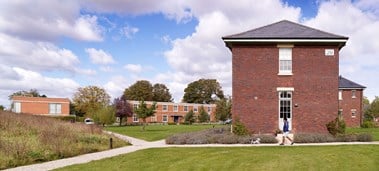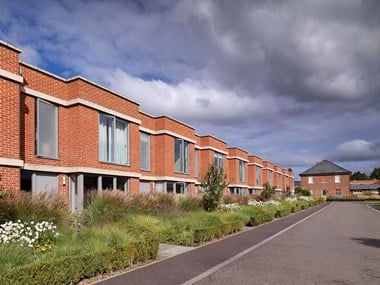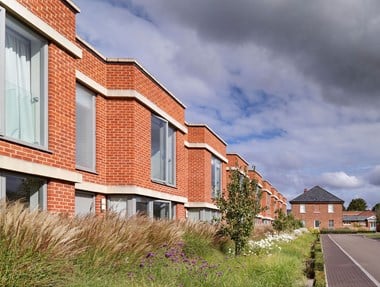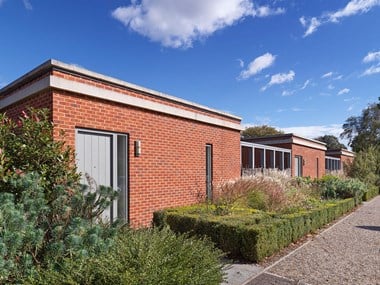Design Case Study: Garden Quarter, Caversfield, Oxfordshire
The re-development of a former RAF site into a residential community with sensitively-designed infill development and conversion of the historic military buildings, united by landscape enhancements.
This case study is one of ten studies of new residential or mixed-use developments compiled in 2020 by Purcell on behalf of Historic England.
Project Information
- Region: South East
- Type of development: Former military site
- Location and postcode: Bicester, Oxfordshire, OX26
- Local planning authority: Cherwell District Council
- Architects: Feilden+Mawson
- Developer/landowner: City & Country
- No. of residential units: 187 (160 conversion; 27 new builds)
- Site area: 9.27 hectares
- Other Uses: Shop and café
Description of development
The scheme at Caversfield sought to re-develop part of the former RAF Bicester site as a residential community. It was previously referred to as the ‘domestic’ site to distinguish it from the ‘technical’ site and airfield across the road. RAF Bicester is recognised as one of the most intact early 20th-century military sites in England, retaining a distinctive group of accommodation and other ancillary buildings on the domestic site. Modern accretions were demolished to better reveal the historic buildings, which were converted into residential dwellings, and new houses were strategically positioned in alignment with the existing buildings. The extensive hard landscaping was reduced and a group of three ‘greens’ was introduced, framed by the different groups of buildings.
Heritage assets affected
The site is located within the RAF Bicester Conservation Area. There are also 12 individual Grade II listings on the site, recognising the distinctive military use and character of the structures. These include barracks, mess buildings and stores. On the opposite side of the road are further listed buildings and scheduled monuments on what was formerly the technical part of the airbase and the adjoining airfield.
Planning context
Under planning legislation at the time, the development required planning permission, listed building consent and conservation area consent. A Design Brief was prepared by Cherwell District Council in 2009 following the preparation of a Conservation Area Appraisal in 2008.
Assessment of design qualities and relationship to historic environment
The scheme challenged initial assertions that the site would not be suitable for residential conversion and sought to balance the cost of conserving the listed buildings with enabling development that enhanced the distinctive character of the site. Early heritage assessment identified the strong group value of the buildings and the spatial relationships across the site. The principal consideration in evolving the scheme was consequently the enhancement of this character. This was achieved through the demolition of detracting later extensions and the strategic positioning of new buildings that respected the axial configuration of the site and the generous spacing between buildings (which was originally planned to mitigate potential bomb damage).
The location and orientation of the new buildings was strongly influenced by the relationships created with the existing buildings and spaces. At the northern end of the site two new residential terraces have been added, bordering the open space in front of the former Officers Mess (Buildings 16) and the former Dining Room & Institute (Building 20). They frame the new Orchard Square in the centre, replacing the car park previously located there.
On the southern half of the site, the original barrack blocks dating from the 1920s are placed symmetrically on either side of the former parade ground (now an open grassed area). The demolition of a detracting later building left a vacant plot on the west side of the parade ground where new development could be sensibly placed. This has been filled by the addition of a new building matching the style of one of the original barrack blocks. Four detached villa-style houses have been introduced along the west site of the site within the site’s green edge where their domestic curtilage can be disguised. Similarly, three new single-storey houses are arranged in parallel formation behind Building 25, near the eastern boundary of the site. A new lodge marks the entrance to the site, echoing the status and character that is typical of a military site.
The new buildings continue the use of flat roofs and concrete string courses above the ground and first floors, which emphasises their horizontality and echoes the Art Deco characteristics of the site’s 1930s buildings. The restrained and orderly detailing of the new terraced houses and villas sits comfortably with the military architecture of the inter-war buildings; for example, the villas have taken inspiration from the Art Deco Watch Office on the adjacent technical site, but without direct imitation.
The Design Brief set out comprehensive guidelines for how the character of the site should be retained and enhanced. This included the signage, rooflines, pointing, colour schemes, domestic ephemera (aerials, refuse points, etc.) and means of enclosure so that the obvious ‘domestication’ of the site was avoided and its military character was preserved. It also highlighted the potential benefit of an Article 4 Direction for the future management of change, although this has not been implemented to date.
Due to their functional character and continued military use for a century, the historic buildings proposed for residential conversion retained very little original ornamentation and had been subject to ad hoc alteration. To reinvigorate the uniformity of the buildings across the whole site, missing or mismatched features such as windows and chimney pots were replaced. Patches of incongruous pointing repairs were raked out and re-applied to match the historic finish, a minor element of work but which strongly emphasised the consistency of the brickwork across the site.
The existing and new buildings were further tied together through the landscaping scheme. Key to this was the creation of three ‘garden squares’, echoing the open character of the parade ground at the south end of the site and two further open spaces in the centre and at the north end of the site. Previously, there had been extensive hard landscaping and car parking provisions close up against the listed buildings, which were detracting from their architectural value. The setting of the listed buildings and overall character of the site have been enhanced with the dispersal of the car parking and introduction of new green spaces.
Key points
The residential re-development of the site was initially considered to be unsuitable as domestic use had the potential to conflict with its distinctive military character, which had survived remarkably intact. Uncertainty around whether military activity would continue on the site after the MOD had vacated the airfield opposite also meant that recommendations in the Conservation Area Appraisal specific to this site were vague. The impetus was consequently on the developer to investigate and prove the optimum viable use which still fulfilled the requirements to preserve and enhance the heritage assets. With several major residential new-build developments across the town (including another former MOD site), there was the potential for ‘consultation fatigue’ within the community. Local interest had the benefit of maintaining community engagement and confirmed support for a residential scheme over other options.
The success of the new buildings stems from how the master plan and design details respect the site’s historic configuration and functional simplicity of the historic military buildings. As a consequence, the new development sits comfortably within their setting and compliment the revived listed buildings.
Views of the Garden Quarter, Caversfield
Please click on the gallery images to enlarge.
-
Design in the Historic Environment
Principles and case studies for good practice in design when making changes to the built historic environment.
-
Design in the Historic Environment: Case Studies
Download all ten case studies as a PDF document.
-
Design Case Study: Roussillon Park Chichester, West Sussex
A case study of design in the historic environment: Roussillion Park is a modern residential complex at the site of a former barracks in Chichester.
-
Wildernesse House Mews, Sevenoaks
Case study of a new mews-style development within the setting of a Grade II listed mansion and within an area of historic landscape.
-
Bourne Estate, Holborn, London
An award-winning residential extension on a Grade II listed urban estate, bringing together old and new through quality detailing and landscaping.
-
Design Case Study: 168 Upper Street, Islington
A case study of an imaginative reinstatement of a missing corner building in Islington that reproduces the original facade.
-
Temple Gardens, Temple Cloud
Design case study of the refurbishment and viable reuse of a listed pub, with a sensitive scheme of new housing and hotel development.
-
Fairmile Hospital
Case study of the re-development of a former hospital on the edge of a rural village with new homes designed as distinctive groups.
-
Church Fields, Boston Spa
A design case study featuring a residential extension to the edge of an historic village that interprets traditional architectural forms.
-
Timekeepers Square, Salford
Case study of a redevelopment that recreates the vernacular Georgian terrace and urban grain within the setting of a listed church.
-
Welsh Streets Liverpool 8
Case study of an ambitious and popular scheme that converts hundreds of derelict Victorian terraced houses.











